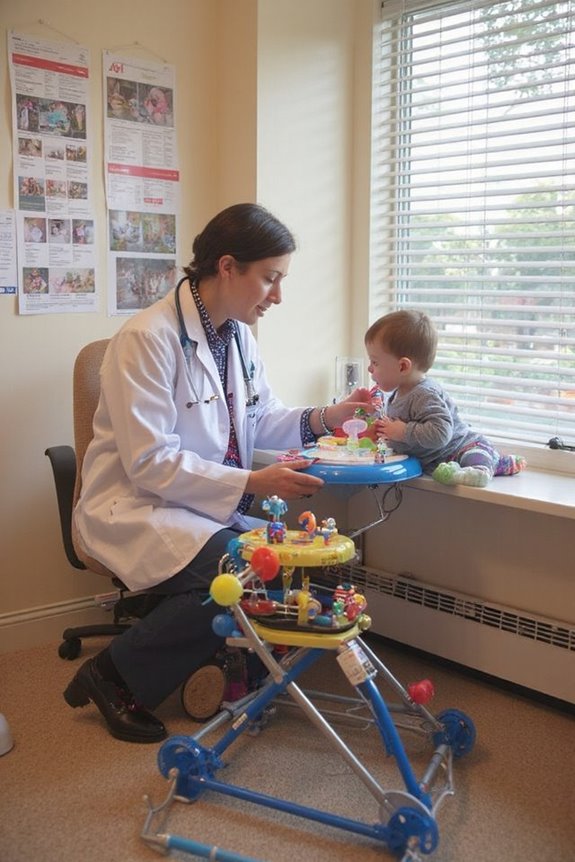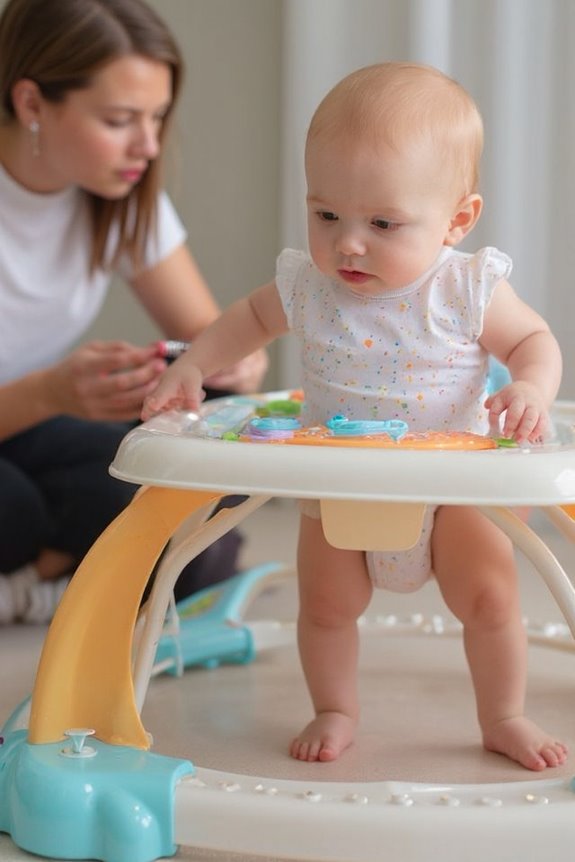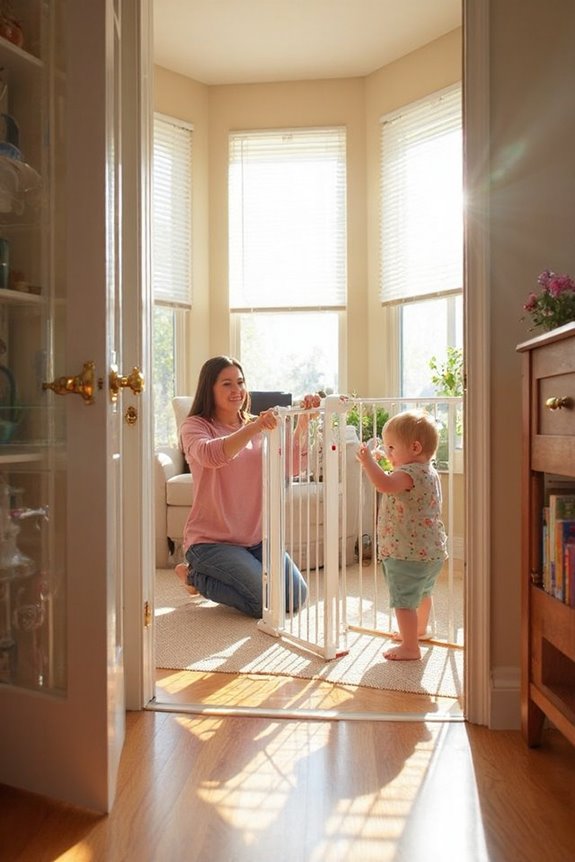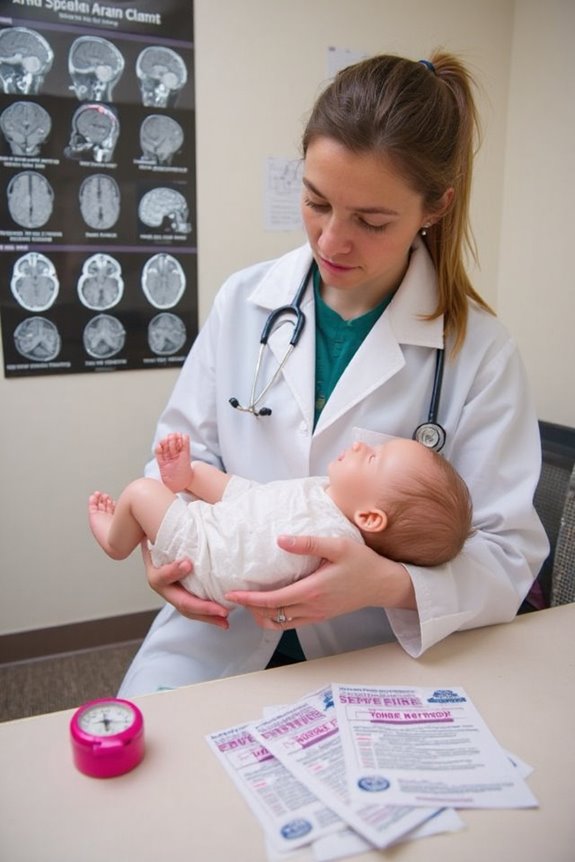Baby walkers pose significant dangers to infants. Studies show 12-50% of children using walkers sustain injuries, with 30% suffering serious head trauma. They don’t help babies walk sooner—they actually delay walking milestones by about 3.3 days for each 24 hours of use. The American Academy of Pediatrics advises against them, and Canada banned them entirely in 2004. Safer alternatives include activity mats, stationary centers, and push toys. The following sections explain why these risks outweigh any perceived benefits.
Key Takeaways
- Baby walkers are associated with high injury rates, with 12-50% of users sustaining injuries and 30% experiencing serious head trauma.
- Studies show walkers may delay developmental milestones, with each 24 hours of use potentially delaying independent walking by 3.3 days.
- Walker-related dangers include falls down stairs, access to hazardous areas, and tipping over, with falls accounting for 74.1% of incidents.
- No scientific evidence supports claims that walkers help babies learn to walk earlier; they may actually hinder natural movement development.
- Safer alternatives include activity mats, stationary play centers, push toys, and supervised floor play that promote proper skill development.
The Alarming Safety Record of Baby Walkers
While baby walkers may seem like helpful tools for infant mobility, they’re associated with a disturbing safety record that every parent should know about. The statistics are alarming: between 12% and 50% of children using walkers sustain injuries, with 30% of these being serious head traumas like concussions or skull fractures.
Baby walker injuries most commonly occur when infants:
- Fall down stairs
- Access dangerous areas like kitchens or pools
- Tip over on uneven surfaces
These safety concerns have prompted the American Academy of Pediatrics to officially advise against their use. Despite improved safety standards in the U.S., incidents continue to occur at troubling rates. Canada recognized these hazards and implemented a complete ban on baby walkers in 2004, highlighting the severity of the risk these devices pose to developing infants.
Understanding Walker-Related Injury Statistics
Looking more closely at the numbers reveals a sobering picture of baby walker dangers. Between 1990 and 2014, over 230,000 children under 15 months required emergency treatment for walker-related injuries.
The data shows:
- Head/neck injuries account for 91% of all cases
- Nearly one-third result in concussions or skull fractures
- 74.1% of incidents involve falls down stairs
- 4% of injured children require hospital admission
While incidents peaked at nearly 21,000 in 1990 and declined to about 2,000 by 2014, the risk remains significant. The consistent pattern of serious injuries underscores the critical need for injury prevention strategies and safety education for parents. Despite warnings and safety measures, baby walkers continue to pose hazards comparable to road traffic accidents for infants under two years.
Developmental Myths vs. Scientific Reality
Despite widespread marketing claims that baby walkers enhance infant development, the scientific evidence tells a dramatically different story. The gap between parental beliefs and scientific reality represents one of the most persistent developmental misconceptions in infant care.
Research consistently shows:
- No evidence that walkers help babies walk earlier
- Some studies suggest walkers may actually delay motor milestones
- No proven cognitive benefits from walker use
- Potential negative impacts on trunk control and natural movement
Many parents—particularly first-time mothers and those with less education—believe walkers provide developmental advantages and keep babies safely occupied. However, scientific evidence contradicts these assumptions. Multiple literature reviews have failed to find any developmental benefits, while some research indicates walkers may interfere with the natural progression of motor skills acquisition.
Impact on Motor Skill Acquisition in Infants
As parents consider baby walkers for their infants, they should understand the significant negative effects these devices have on motor development. Research shows each 24 hours of walker use can delay independent walking by approximately 3.3 days—a statistically significant finding (P < 0.001).
Key developmental concerns include:
- Trunk control impairment, vital for proper walking ability
- Delays in standing (3.7 days per 24 hours of use)
- Disrupted crawling and sitting skill acquisition
Baby walkers prevent infants from experiencing natural motor development stages, including weight transfer and balance practice. Despite their popularity for keeping babies occupied, walkers offer no positive influence on motor skills while potentially causing motor development delays.
The natural progression of rolling, sitting, and crawling builds essential muscle strength that walkers inadvertently bypass.
Medical Community’s Stance on Walker Usage

The medical community has taken a firm stance against baby walkers based on overwhelming evidence of their dangers. The American Academy of Pediatrics (AAP) explicitly recommends against their use, citing alarming statistics:
- Over 9,000 U.S. children are injured annually in walker-related incidents
- Approximately 21 children are hospitalized daily with walker injuries
- Even with supervision, serious accidents occur due to the walker’s speed
Current pediatric recommendations strongly favor safer alternatives like stationary play centers or playpens. Despite manufacturers adding safety features like brakes and door stoppers, medical guidance remains consistent: baby walkers provide no developmental benefits while introducing significant risks of falls, burns, and poisoning.
I’ve found that parents often don’t realize that infants in walkers can move at speeds exceeding 3 feet per second—too fast for even vigilant caregivers to react.
Safer Alternatives for Mobile Babies
While medical professionals stand firmly against baby walkers, many parents still want to support their babies’ natural desire to move. I recommend several safer options that promote healthy development:
- Activity mats provide a protected space for exploration while strengthening your baby’s entire body through tummy time and reaching exercises.
- Mobile activity centers offer stationary play stations where babies can bounce, spin and play without the risks associated with walkers.
- Push toys support practicing walking skills in a controlled manner.
These alternatives deliver key benefits including:
- Proper motor skill development
- Natural balance and coordination building
- Cognitive stimulation through interactive features
- Safe positioning that supports appropriate muscle development
Parents consistently report greater peace of mind with these options while still encouraging their babies’ mobility milestones.
Regulatory Changes and Safety Standards
Safety standards governing baby walkers have undergone substantial transformations since their initial establishment in 1971, creating a more protective environment for our youngest consumers. The Consumer Product Safety Improvement Act of 2008 marked a pivotal shift from voluntary to mandatory compliance with ASTM F977 standards.
Key regulatory compliance measures now include:
- Mandatory stair fall testing
- Parking brake evaluations
- Stability requirements
I’ve observed that these enhanced regulations have considerably reduced walker-related injuries, which previously numbered around 2,000 emergency room visits annually. The CPSC conducts ongoing safety evaluation to guarantee manufacturers meet these standards.
When shopping for baby mobility products, you’ll notice that today’s walkers incorporate these protective features—a direct result of stricter federal oversight and industry adaptation to prevent accidents.
Why Parents Continue to Use Walkers Despite Warnings
Despite overwhelming evidence highlighting the dangers of baby walkers, many parents still introduce these devices into their homes, creating unnecessary risks for their infants. I’ve found that several factors contribute to this concerning trend:
- Parental beliefs about development remain strong, with many caregivers incorrectly assuming walkers help babies learn to walk faster
- Lack of awareness about the 9,000+ injuries occurring annually
- Cultural influences and family traditions that normalize walker use across generations
- Marketing that emphasizes entertainment value while downplaying risks
- Limited access to accurate safety information in some communities
- Parental beliefs about development remain strong, with many caregivers incorrectly assuming walkers help babies learn to walk faster
When pediatricians don’t specifically address walker dangers, parents often default to what seems convenient. Additionally, without affordable and accessible alternatives, many families continue using these potentially harmful devices despite warnings.
The Hidden Risks Beyond Physical Injuries
The physical dangers of baby walkers represent only part of the risk profile parents should consider. These devices can also impact developmental progression in ways many caregivers don’t anticipate:
- Developmental delays: Walkers may interfere with significant motor skill development including crawling, sitting, and independent walking
- Visual-motor integration issues: Babies can’t see their legs moving, disrupting natural body awareness development
- Psychological impacts: Infants may develop dependency on walkers, potentially hindering their natural drive for independent mobility
Cultural perceptions often normalize walker use despite these concerns. Many parents receive mixed messages from marketing, peers, and family traditions that emphasize convenience over developmental considerations.
Even with supervision, babies in walkers can move at speeds exceeding 3 feet per second, accessing hazards before adults can intervene—a risk that transcends simple fall prevention.
Making Informed Decisions About Infant Mobility Tools
When parents evaluate options for their baby’s mobility development, they’ll need thorough information to navigate the complex landscape of infant mobility tools.
I recommend considering these safer alternatives:
- Stationary activity centers
- Supervised floor play mats
- Playpens with age-appropriate toys
Despite safety improvements in 2010, baby walkers still present significant risks with minimal developmental benefits. In fact, research suggests they may delay walking milestones.
The dramatic reduction in injuries—from 21,000 in 1990 to 3,200 in 2003—demonstrates how parental education impacts safety outcomes. However, even with improved standards, injuries persist.
When making your decision, prioritize both safety and developmental needs. Your infant can develop mobility skills effectively through alternatives that don’t carry the documented risks of traditional walkers.
Frequently Asked Questions
At What Age Do Most Walker-Related Injuries Occur?
Most walker-related injuries occur around 9 months of age. I’d emphasize that during this critical stage of infant mobility, safety precautions are essential as children are exploring but lack judgment about dangerous situations.
Are Walker Safety Standards Different in Other Countries?
Picture a global patchwork of safety nets: I’m seeing stark differences in walker safety standards internationally. The U.S. and EU have regulations while Canada has banned them entirely—reflecting both international regulations and cultural differences in child safety approaches.
Can Modified or Homemade Walkers Reduce Injury Risks?
No, I don’t recommend modified or homemade walkers. Despite added safety features, homemade designs lack proper testing and still allow children to reach dangerous areas quickly. The fundamental risks remain unchanged regardless of modifications.
How Long Do Babies Typically Use Walkers Before Walking Independently?
I’ve found that 50-77% of parents use walkers! Babies typically use them for 2-3 months before reaching independent walking developmental milestones. The timing varies widely based on individual baby mobility patterns and when walkers are introduced.
Do Walker Injuries Result in Long-Term Developmental Consequences?
While research on long-term effects is limited, I’m concerned that serious walker injuries, especially head trauma, could potentially impact developmental milestones. That’s why I strongly emphasize injury prevention through safer alternatives for babies.





